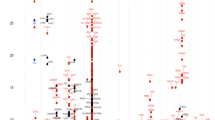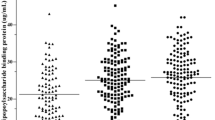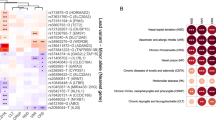Abstract
Nut allergy is an important and potentially life threatening food allergy with a prevalence of one in 150 children in the UK population. STAT6 (signal transducer and activator of transcription) is an important molecule in the induction and regulation of an allergic response, which maps to chromosome 12q in a region previously linked with total serum IgE concentration and atopy in different populations. We have examined the frequency of a single nucleotide polymorphism (SNP) in the 3′UTR region of STAT6 gene in 71 UK Caucasoid patients diagnosed with nut allergy and 45 atopic patients without nut allergy using PCR-RFLP and compared these with 184 UK healthy controls. The STAT6 G allele frequency was significantly increased in nut allergy patients compared with blood donor controls (P < 0.0001, OR = 2.9, 95% CI: 1.7–4.9), which was under a recessive model (GG vs GA+AA, P = 0.0001, OR = 3.2, 95% CI: 1.7–5.8) but not in atopic patients without nut allergy. The G allele was most frequent in the severe cases and GG homozygosity was associated with the increased risk of severe reaction (OR = 3.9, 95% CI: 1.9–8.3). We conclude that STAT6 3′UTR polymorphism is associated with susceptibility and severity in nut allergic patients in our population.
This is a preview of subscription content, access via your institution
Access options
Subscribe to this journal
Receive 6 digital issues and online access to articles
$119.00 per year
only $19.83 per issue
Buy this article
- Purchase on Springer Link
- Instant access to full article PDF
Prices may be subject to local taxes which are calculated during checkout
Similar content being viewed by others
References
Sicherer SH, Sampson HA . Peanut and tree nut allergy Curr Opin Pediatr 2000 12: 567–573
Bock SA . Prospective appraisal of complaints of adverse reactions to foods in children during the first 3 years of life Pediatrics 1987 79: 683–688
Emmett SE, Angus FJ, Fry JS, Lee PN . Perceived prevalence of peanut allergy in Great Britain and its association with other atopic conditions and with peanut allergy Allergy 1999 54: 380–385
Sampson HA, Mendelson L, Rosen JP . Fatal and near-fatal anaphylactic reactions to food in children and adolescents N Engl J Med 1992 327: 380–384
Walley AJ, Cookson WO . Investigation of an interleukin-4 promoter polymorphism for associations with asthma and atopy J Med Genet 1996 33: 689–692
Barnes KC, Marsh DG . The genetics and complexity of allergy and asthma Immunol Today 1998 19: 325–332
Barnes KC, Neely JD, Duffy DL et al. Linkage of asthma and total serum IgE concentration to markers on chromosome 12q: evidence from Afro-Caribbean and Caucasian populations Genomics 1996 37: 41–50
Nickel R, Wahn U, Hizawa N, Maestri N, Duffy DL, Barnes KC . Evidence for linkage of chromosome 12q15-q24.1 markers to high total serum IgE concentrations in children of the German Multicenter Allergy Study Genomics 1997 46: 159–162
Thomas NS, Wilkinson J, Holgate ST . The candidate region approach to the genetics of asthma and allergy Am J Respir Crit Care Med 1997 156: S144–S51
Takeda K, Tanaka T, Shi W et al. Essential role of Stat6 in IL-4 signalling Nature 1996 380: 627–630
Kaplan MH, Schindler U, Smiley ST, Grusby MJ . Stat6 is required for mediating responses to IL-4 and for development of Th2 cells Immunity 1996 4: 313–319
Takeda K, Kamanaka M, Tanaka T, Kishimoto T, Akira S . Impaired IL-13-mediated functions of macrophages in STAT6-deficient mice J Immunol 1996 157: 3220–3222
Miyata S, Matsuyama T, Kodama T et al. STAT6 deficiency in a mouse model of allergen-induced airways inflammation abolishes eosinophilia but induces infiltration of CD8+ T cells Clin Exp Allergy 1999 29: 114–123
Zurawski G, de Vries JE . Interleukin 13, an interleukin 4-like cytokine that acts on monocytes and B cells, but not on T cells Immunol Today 1994 15: 19–26
Leek JP, Hamlin PJ, Bell SM, Lench NJ . Assignment of the STAT6 gene (STAT6) to human chromosome band 12q13 by in situ hybridization Cytogenet Cell Genet 1997 79: 208–209
Amoli M, Ollier WE, Hajeer AH . A novel PCR-RFLP assay for the detection of a polymorphism in the 3′ of STAT6 gene Genes Immun 2000 1: 349–350
Huss K, Naumann PL, Mason PJ et al. Asthma severity, atopic status, allergen exposure and quality of life in elderly persons Ann Allergy Asthma Immunol 2001 86: 524–530
Jacob CO, Lee SK, Strassmann G . Mutational analysis of TNF-alpha gene reveals a regulatory role for the 3′-untranslated region in the genetic predisposition to lupus-like autoimmune disease J Immunol 1996 156: 3043–3050
Hourihane JO, Dean TP, Warner JO . Peanut allergic subjects’ peripheral blood mononuclear cell proliferative responses to crude peanut protein Clin Exp Allergy 1998 28: 163–168
Clarke MC, Kilburn SA, Hourihane JO, Dean KR, Warner JO, Dean TP . Serological characteristics of peanut allergy Clin Exp Allergy 1998 28: 1251–1257
Dorion BJ, Leung DY . Selective expansion of T cells expressing V beta 2 in peanut allergy Pediatr Allergy Immunol 1995 6: 95–97
Moffatt MF, Hill MR, Cornelis F et al. Genetic linkage of T-cell receptor alpha/delta complex to specific IgE responses Lancet 1994 343: 1597–1600
Holgate ST . Asthma genetics: waiting to exhale Nat Genet 1997 15: 227–229
Senechal H, Geny S, Desvaux FX et al. Genetics and specific immune response in allergy to birch pollen and food: evidence of a strong, positive association between atopy and the HLA class II allele HLA-DR7 J Allergy Clin Immunol 1999 104: 395–401
Howell WM, Turner SJ, Hourihane JO, Dean TP, Warner JO . HLA class II DRB1, DQB1 and DPB1 genotypic associations with peanut allergy: evidence from a family-based and case-control study Clin Exp Allergy 1998 28: 156–162
Rosenwasser LJ, Klemm DJ, Dresback JK et al. Promoter polymorphisms in the chromosome 5 gene cluster in asthma and atopy Clin Exp Allergy 1995 25 (Suppl 2): 74–78
Shirakawa T, Li A, Dubowitz M et al. Association between atopy and variants of the beta subunit of the high-affinity immunoglobulin E receptor Nat Genet 1994 7: 125–129
Moffatt MF, Cookson WO . Genetics of asthma and inflammation: the status Curr Opin Immunol 1999 11: 606–609
Author information
Authors and Affiliations
Corresponding author
Rights and permissions
About this article
Cite this article
Amoli, M., Hand, S., Hajeer, A. et al. Polymorphism in the STAT6 gene encodes risk for nut allergy. Genes Immun 3, 220–224 (2002). https://doi.org/10.1038/sj.gene.6363872
Received:
Accepted:
Published:
Issue Date:
DOI: https://doi.org/10.1038/sj.gene.6363872
Keywords
This article is cited by
-
Genome-wide association study identifies peanut allergy-specific loci and evidence of epigenetic mediation in US children
Nature Communications (2015)
-
Single nucleotide polymorphisms (SNPs) in key cytokines may modulate food allergy phenotypes
European Food Research and Technology (2012)
-
Early life precursors, epigenetics, and the development of food allergy
Seminars in Immunopathology (2012)
-
An asthma-associated genetic variant of STAT6 predicts low burden of ascaris worm infestation
Genes & Immunity (2004)
-
Association studies for asthma and atopic diseases: a comprehensive review of the literature
Respiratory Research (2003)



